His work graces the projects of many an interior designers and his refreshing attitude to creating (his “anything goes” approach makes his work brilliantly intuitive and void of pretension) is something a lot of artists could take note of. We caught up with Ben Lowe – the man behind the canvas – to discuss which subjects inspire him most, his creative process and the need for imperfections and honesty in art.

Interview with Ben Lowe, London Based Artist
The interior designer-approved artist on his abstract expressionism

Can you tell us about your route into the art industry?
I originally trained as a graphic designer through an apprenticeship; but art was always my passion so I ditched the design career to pursue painting full-time in 2000. To stay afloat, I spent 90% of my time making artwork for commercial projects – mainly for designers and art consultants. That was 16 years ago and I’m fortunately now in a position to dedicate most of my time to my own practice.
Which artists or art movements have inspired your work?
I’ve taken so many things from so many artists over the years – I’m sure it’s all rubbed off in one way or another. I wouldn’t want to pigeonhole myself into one style too much but it would be fair to say that my work is reminiscent of the abstract expressionism of the 50s which is little surprise because I weaned myself on the big names of the oeuvre – Gorky, De Kooning, Kline, Rothko, etc. I’m also an unashamed Francis Bacon and Tracey Emin fan and would dearly like to own Carrying Mattresses by the brilliant Stanley Spencer.
Emotion plays a huge role in your art. In what way can your painting be viewed as autobiographical?
To an extent, all of it could be, even my landscapes, which I paint not for the purpose of recreating a pretty vista, rather to represent a specific memory or place in my heart that a place holds. My paintings need to resonate with my life experiences in the same way a diary would. It’s easy to take yourself too seriously as an artist, so I try to observe lighter-hearted things as well as the heavy stuff. Grayson Perry projects his personality and sense of humour brilliantly through his work – for which I admire him greatly.
Of course each piece is different but what’s your general creation process?
I‘ve a constantly evolving wealth of source imagery which I amass from all over the place (I’m a magpie), which provides me with visual triggers. I also have a burgeoning wall full of ideas that I want to explore, often just in the form of potential titles or scribbled concepts. I’m constantly trying different things out, seeing how they relate to one another and to the original concept. Eventually things start to reveal themselves and can then get refined accordingly. Some paintings evolve entirely from their original concept and transform into a completely different narrative. I find it hard to plan paintings as it stifles the actual making too much. It’s a reactionary process and needs to be as fluid as possible or it risks becoming contrived.
Some works are scratched at, others take on the form of watercolours and others still are a much more intense oil paintings. How would you describe the breadth of your painting style?
I like to try different things, partly to make things interesting for myself and partly to give the collections depth and variety. Certain concepts might call for a small, simple ink drawing on paper while others command larger canvases with more detail. I have a studio full of weird and wonderful tools for applying and working paint. None of which are particularly sophisticated.

How long do you spend on each piece?
Paintings are like crosswords – some reveal themselves overnight and others take months, or even years, to conclude. My painting titled ’96 gets its name because I started it in 1996 and finished it in 2013. There’s also a period of evaluation after a painting is complete, which is another important part of the process. We hang pictures around the house and ponder them outside of the studio setting; before making any changes or letting them go. Quality control is obviously very important.
What is it about oil on canvas – your chosen medium – that lends well to your style?
I can remember being given a lovely old wooden box full of brushes and oils when I was about 14. It belonged to a relative who’d passed away and it engulfed you in a haze of turpentine every time you opened it. It was so evocative and exciting that I immediately embraced it as my ‘thing’ and have primarily painted with them ever since. I love the way you can use it across the spectrum – from heavy impasto all the way through to ‘watery’ washes of colour, all to great effect. I do also use other mediums though so it’s not an exclusive relationship, but the richness and charm of oil is certainly hard to beat.
You say that the joy of your work is being inspired by anything – nature, relationships, etc. Which element of such varying experiences is the real inspiration to you?
Good question. I genuinely take real pleasure in trying to find inspiration from all around – to keep my eyes and ears open until I connect with something so powerfully that it warrants a painting. Relationships provide the deepest and richest stream of inspiration for me though and nature throws up ideas every now and then; but I’m not the kind of artist who’d set up an easel in a field of lavender.
Is there any subject that you’re regularly drawn to?
Childhood memories crop up a lot. I’m currently also referencing the emotions connected to being the parent of two young boys under six. Parenthood drives you into a unique mental space. It’s a bit like having to deal with being burgled every day, continuously. It’s a hugely rewarding test of physical and emotional endurance.
Your paintings make careful use of colour. What do you enjoy so much about a nearly colourless palette?
I’m OK to go ‘full-on’ with colour – so long as it’s the primary motif for making a painting (which is rare) otherwise I prefer to use it sparingly and with respect. If I think about all my favourite paintings, I don’t revere them for the colours the artist has used. It’s about the technique, concept, materials or subject matter. That’s not to say that I live in a world dominated by black and white; our home is full of 1950s colour. In fact it’s looking more and more like the set of Call The Midwife every day.
What’s been your career highlight to date?
I’d say sustaining a good career and being self-sufficient for over fifteen years now is my highlight. It’s a constant juggling act when you represent yourself, and being an artist is an all-consuming job. I have to constantly remind myself that ‘“t’s all about the art” to ensure I don’t let the boring ‘business stuff’ get in the way of the creativity and the productivity. Fortunately my wife (wedding dress designer, Ellie Lowe) is in exactly the same boat so we can lean on one another when the going gets tough.
Your most recent collection ‘Pictures of the Dark’ explores the theme of life’s imperfections. What is so intriguing about those to you?
I’ve always been a lot more interested in the darker corners of human condition rather than the flowery facades. That usually means scratching beneath the glossy veneers or pulling back the curtain to see the inner workings. Imperfections and honesty are like the proverbial cheese and pickle.
What are you finding yourself working on at the moment?
Foremost, I’m working on my next collection for release later this year which includes a painting called ‘Hero’, dedicated to David Bowie, and ‘Duck With Figs’ – a tribute to a hilariously disastrous meal that was cooked for me recently. Commission-wise, I’ve got a few residential projects which I’m providing artwork for, all in Central London, and I’ve also been asked to create a pair of canvases for an incredibly beautiful yacht that’s currently being built in Bath.
